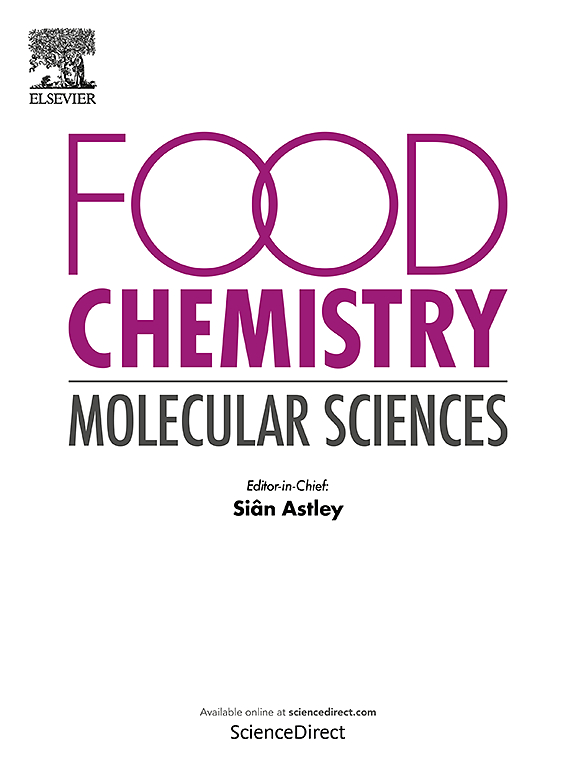不同发育阶段鸽子胸肌脂肪酸组成及基因调控网络分析
IF 4.7
Q2 FOOD SCIENCE & TECHNOLOGY
引用次数: 0
摘要
脂肪酸组成是决定肉品质的关键。鸽肉以其柔软的质地、高蛋白含量和丰富的多不饱和脂肪酸(PUFAs)而闻名,但其肌内脂肪酸沉积的发育动力学和分子机制尚不清楚。先前的研究表明,脂质代谢通常由协调的基因表达程序控制。因此,我们假设鸽子肌肉中的脂肪酸谱是由加权基因共表达网络分析(WGCNA)识别的基因共表达模块调节的。为了验证这一点,我们使用气相色谱-质谱(GC-MS)和转录组测序分析了鸽子在5个发育阶段(28天至48个月)的胸肌。总共鉴定出39种脂肪酸,随着时间的推移,关键的PUFAs如DHA增加和EPA减少,而总体MUFAs减少,PUFAs在6个月时达到峰值,揭示了脂肪酸组成的不同阶段依赖模式。WGCNA显示,三个基因模块(绿色、黄色、绿松石色)与脂肪酸性状显著相关。氧化石墨烯富集分析表明,它们参与核糖体活性、线粒体途径和不饱和脂肪酸生物合成,而KEGG途径则参与氧化磷酸化和磷脂酰肌醇信号传导。蛋白质-蛋白质相互作用(PPI)分析确定了枢纽基因,包括RPS16, NDUFS6, RHOJ和NUDT12是脂肪酸代谢的关键调节因子。本研究首次在鸽子中建立了脂肪酸组成与转录调控的共表达网络,拓宽了WGCNA在禽类脂质代谢中的应用。这些发现为研究脂肪沉积的基因网络提供了新的见解,并为通过分子育种改善肉质提供了靶点。本文章由计算机程序翻译,如有差异,请以英文原文为准。
Fatty acid composition and gene regulatory network analysis of pectoral muscle in pigeons across developmental stages
Fatty acid composition is crucial for determining meat quality. Pigeon meat, renowned for its tender texture, high protein content, and abundant polyunsaturated fatty acid (PUFAs), yet the developmental dynamics and molecular mechanisms of intramuscular fatty acid deposition remain unclear. Previous studies suggest that lipid metabolism is often governed by coordinated gene expression programs. Therefore, we hypothesized that fatty acid profiles in pigeon muscle are regulated by gene co-expression modules identifiable via weighted gene co-expression network analysis (WGCNA). To test this, we analyzed pectoral muscles from pigeons at five developmental stages (28 days to 48 months) using gas chromatography–mass spectrometry (GC–MS) and transcriptomic sequencing. A total of 39 fatty acids were identified, with key PUFAs such as DHA increasing and EPA decreasing over time, while overall MUFAs declined and PUFAs peaked at 6 months, revealing distinct stage-dependent patterns in fatty acid composition. WGCNA revealed that three gene modules (green, yellow, turquoise) were significantly associated with fatty acid traits. GO Enrichment analysis indicated their involvement in ribosome activity, mitochondrial pathways, and unsaturated fatty acid biosynthesis, while KEGG pathway highlighted oxidative phosphorylation and phosphatidylinositol signaling. Protein-protein interaction (PPI) analysis pinpointed hub genes, including RPS16, NDUFS6, RHOJ, and NUDT12 as key regulators of fatty acid metabolism. This study provides the first co-expression network linking fatty acid composition with transcriptional regulation in pigeons, broadening WGCNA application in avian lipid metabolism. The findings offer new insights into gene networks underlying lipid deposition and suggest targets for improving meat quality through molecular breeding.
求助全文
通过发布文献求助,成功后即可免费获取论文全文。
去求助
来源期刊

Food Chemistry Molecular Sciences
Agricultural and Biological Sciences-Food Science
CiteScore
6.00
自引率
0.00%
发文量
83
审稿时长
82 days
期刊介绍:
Food Chemistry: Molecular Sciences is one of three companion journals to the highly respected Food Chemistry.
Food Chemistry: Molecular Sciences is an open access journal publishing research advancing the theory and practice of molecular sciences of foods.
The types of articles considered are original research articles, analytical methods, comprehensive reviews and commentaries.
Topics include:
Molecular sciences relating to major and minor components of food (nutrients and bioactives) and their physiological, sensory, flavour, and microbiological aspects; data must be sufficient to demonstrate relevance to foods and as consumed by humans
Changes in molecular composition or structure in foods occurring or induced during growth, distribution and processing (industrial or domestic) or as a result of human metabolism
Quality, safety, authenticity and traceability of foods and packaging materials
Valorisation of food waste arising from processing and exploitation of by-products
Molecular sciences of additives, contaminants including agro-chemicals, together with their metabolism, food fate and benefit: risk to human health
Novel analytical and computational (bioinformatics) methods related to foods as consumed, nutrients and bioactives, sensory, metabolic fate, and origins of foods. Articles must be concerned with new or novel methods or novel uses and must be applied to real-world samples to demonstrate robustness. Those dealing with significant improvements to existing methods or foods and commodities from different regions, and re-use of existing data will be considered, provided authors can establish sufficient originality.
 求助内容:
求助内容: 应助结果提醒方式:
应助结果提醒方式:


